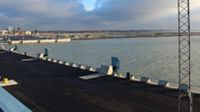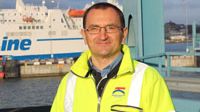
Blogginlägg -
The Port of Trelleborg shares information
– Integrated terminal solution helps in several stages. One of the major challenges for Scandinavia’s largest Ro-Ro terminal is managing the flow of goods and information in several directions. Particularly when the cargo in the Port of Trelleborg is moved between various modes of transport and shipping lines, haulage companies, train operators and cargo owners all need secure access to up-to-date information.
In close collaboration with Hogia, the Port of Trelleborg has created a modern solution whereby Hogia’s terminal operating system (TOS), business system and Warehouse Management System (WMS) are fully integrated and create a goldmine of information for the port, customers, suppliers and other links in the logistics chain.
“On average the terminal system alone handles around 12,000 messages a day, from status reports to amendments and updates. But the solution we’re working on now enables us to act as a hub in the information flow and be the heart of communications between various players, such as train operators and shipping lines,” says Mikael Simonsson, head of IT at the Port of Trelleborg.
From chasing the “green labels” to a quick, secure overviewNot so many years ago the port used paper lists and green labels to indicate and identify which cargo was to go where. This entailed a great deal of time-consuming manual chasing up and meant several sources of error, from labels that had blown away to simple typos. In addition to the extensive paperwork, the old method also relied heavily on verbal communication and there was considerable scope for mistakes and misunderstandings.
“It only took a single employee to be away for just a short time and things could get confused and ineffective. We’ve now reduced the dependency on particular people. Rather than one individual being responsible for important information, now the data, work and responsibility are shared by many,” continues Simonsson.
Mikael Simonsson, head of IT at the Port of Trelleborg, sees major advantages in modern IT support where integrated information becomes an asset for the port and customers alike. Bearing in mind that the ferry traffic averages 30 departures and arrivals a day, it is easy to see the need for an efficient work method.
Cargo no longer moved unnecessarily or wronglyThanks to the integrated terminal solution and handheld computers, everyone is now given the same information simultaneously. This provides a simple overview and answers questions about where the cargo is located, when it came in, where it is headed and how it will be transported. Cargo is no longer moved unnecessarily or wrongly and needless transport is eliminated, because the cargo and logistics chain can be understood in a completely different way to before.
“The new IT support and a revised work method give everyone involved better control and enable us to work more efficiently. Customers also benefit from a far smoother operation as they can receive up-to-date information directly in their own systems. The information now flows digitally and is up to date and accessible in a completely different way to before. It’s also important for us to be able to offer customers precision and an opportunity to track their cargo. This has eliminated many incoming calls. It feels especially important to automate the standard, repetitive work elements as far as possible,” says Simonsson.
Solution for the futureMost figures for the Port of Trelleborg are on the up. The customer base is growing, the volume of cargo is increasing and the port is in the process of an extensive move where a brand new port area will streamline work further and also make it possible to handle vessels up to 240 metres long (the current limit is 200 metres).
“We need to be able to cope with today’s challenges but we also need IT support that is flexible and scalable to handle future changes, not least the ongoing integration with the rest of the logistics chain. We’ll be a port where large quantities of information are an asset, not a problem. Neither will the port be doing time-consuming manual administration when instead we can serve our customers and develop our business,” Simonsson concludes.
Traffic in Trelleborg port in figures (2014): Ferry arrivals & departures per day – approximately 30
Cargo (millions of tonnes) – approximately 10.3 million
Trailers – approximately 128,000
Trucks – approximately 497,000
Railway trucks – approximately 27,000
New damage inspection reduces claims
Since 2007 the port’s TOS has also included information from a damage inspection system whereby each vehicle arriving at the port is photographed in special inspection gates.
“Claims for damages against the port have decreased by around 75% since the system was introduced, and we can now carry out a damage inspection directly in our TOS. It also helps that we’ve employed a claims manager to organise this function. By having reliable information about the vehicle’s condition when it arrives at the port, we’ve been able to dismiss many claims for damages and thereby reduce our costs,” comments Simonsson.


